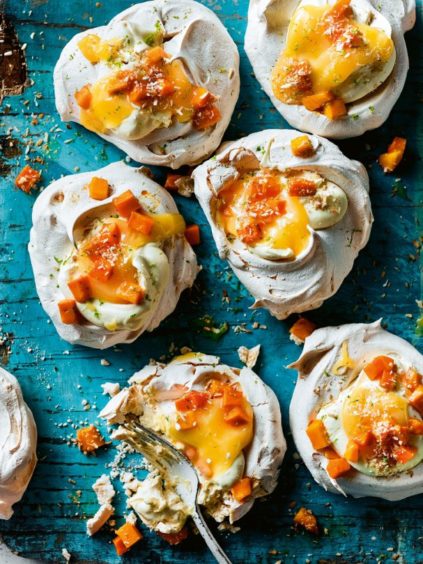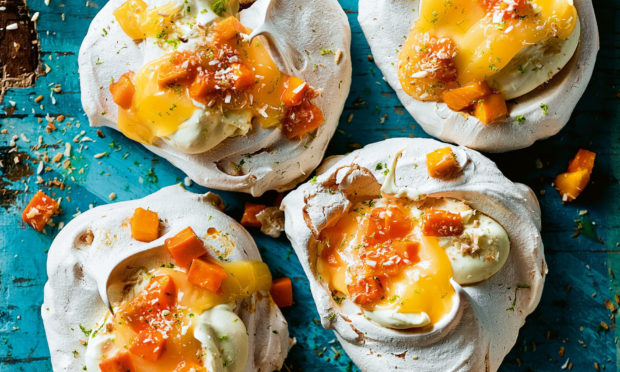Combine the fresh taste of mango with the citric vibe of lime and add some coconut for a truly tropical dessert.
This amazing combination of flavours is a surefire winner and one sweet treat which is ideal when you are entertaining.
You can make your lime curd and meringues the night before which means all you need to do is assemble it for an amazing dish that will have your guests craving more.
Mango, lime and coconut meringues
(Makes 8)

Ingredients
For the meringues:
- 3 egg whites
- 170g caster sugar
For the lime curd:
- Zest and juice of 2 limes
- 3 egg yolks
- 25g unsalted butter
- 50g caster sugar
For assembly:
- 50g unsweetened desiccated coconut
- 300ml double cream
- 200g mango, stoned, peeled and diced into 1cm pieces
Method
- Preheat the oven to 150C/300F/gas mark 2. In a clean and dry mixing bowl, whip the egg whites with an electric whisk.
- Start on a low speed and gradually increase the speed over the next two to three minutes to the highest setting until the egg whites are stiff peaks, then stop.
- Add half the sugar to the egg whites and whisk at high speed, then add the remaining sugar until the meringue is glossy and firm – this usually takes two minutes.
- Line two baking sheets with greaseproof paper. Spoon four mounds of meringue onto each sheet, spaced out evenly.
- Using the back of a spoon, make a shallow dip in the centre of each meringue, where the topping will sit once they’re cooked.
- Place the trays in the oven for 35 minutes; once that time is up, switch off the oven and leave the meringues to cool and dry in there overnight. While the meringues are cooking, prepare the lime curd.
- Make a bain-marie with a heatproof bowl set over some simmering water (make sure the bowl does not touch the water, though) and add all the ingredients for the curd to the bowl.
- Stir to dissolve the sugar and melt the butter.
- Making the curd requires a bit of patience, as it will take anywhere between six and eight minutes to thicken: it should coat the back of a wooden spoon when it is done.
- We then strain it through a sieve, to get rid of the zest, and let it cool before refrigerating overnight in a covered container.
- For the assembly, toast the desiccated coconut in a dry frying pan on the hob, stirring throughout – watch it carefully and don’t let it turn brown, it will only take a minute. Whip the double cream until it’s thick.
- Plate up the meringues, then top each one with a spoonful of cream, a dollop of lime curd, some mango pieces and finally a sprinkling of toasted coconut. Serve immediately.
Recipe from: The Rangoon Sisters: Recipes From Our Burmese Family Kitchen by Emily and Amy Chung, recipe photography by Martin Poole, is published by Penguin, priced £20.
